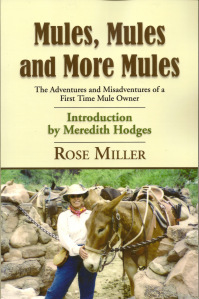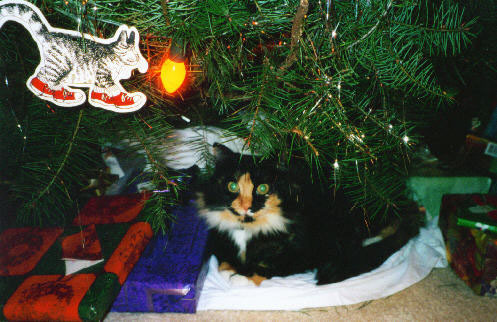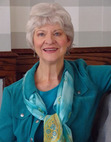Heidi M. Thomas's Blog, page 27
February 2, 2011
(Almost) Wordless Wednesday: What I Did on My Vacation
While my husband attended a trade show in Las Vegas, his sister, Marylou, and I played tourist.
 Lions napping while their trainers stand (er, sit) by at the MGM Grand.
Lions napping while their trainers stand (er, sit) by at the MGM Grand.
 We even "solved" a crime at the "CSI Experience."
We even "solved" a crime at the "CSI Experience."
 Fountains dance to music at the Bellagio.
Fountains dance to music at the Bellagio.
 The Rainforest Cafe at the MGM, complete with thunderstorms and animated jungle residents.
The Rainforest Cafe at the MGM, complete with thunderstorms and animated jungle residents.
 Lunch next to this colorful fish tank at the Rainforest Cafe
Lunch next to this colorful fish tank at the Rainforest Cafe
 A beautiful but deadly jellyfish at the aquarium in Madalay Bay
A beautiful but deadly jellyfish at the aquarium in Madalay Bay
 After Las Vegas, we drove to AZ, where we visited downtown Prescott.
After Las Vegas, we drove to AZ, where we visited downtown Prescott.
 The Jersey Lilly Saloon on "Whiskey Row," Prescott AZ. In my next books, I write about the Jersey Lilly in Ingomar, MT, where my grandparents lived during the 1940s and '50s.
The Jersey Lilly Saloon on "Whiskey Row," Prescott AZ. In my next books, I write about the Jersey Lilly in Ingomar, MT, where my grandparents lived during the 1940s and '50s.








January 15, 2011
If You Can Talk, You Can Write Dialogue, Right?
 Dialogue is two or more characters talking to each other. Should be easy, shouldn't it? Well, maybe not.
Dialogue is two or more characters talking to each other. Should be easy, shouldn't it? Well, maybe not.
Here's what dialogue is:
Talk is an ACTION. An ideal, compact way to advance your story by having one character tell the other what's happening—to reveal, admit, incite, accuse, lie, etc. It can speed up a scene.
A way to define a character. The way someone speaks—accent, vocabulary, idiom, inflection—tells as much about what he is like as his actions do. And let's us see him better than just using description. It can also reveal motive.
One way to show emotion and set a mood. Characters reveal themselves when under stress or angry. Dialogue is used to create an emotional effect in the reader.
Another way to show Point of View (POV).
Often used to get across what is NOT said. Example, if you want to show that someone wants to avoid an unpleasant encounter, you can show this by having them talk around the subject uppermost in their mind, but never quite touch it. In this way, you're asking the reader to read between the lines. It's tricky, but think about how you talk to someone yourself when you're angry at them but don't want to tell them exactly why—by being sarcastic, arch, nitpicky, oversolicitous, etc.
To intensify conflict. Dialogue is often adversarial or confrontational.
Dialogue should be natural, but never the way we really talk.
Example:
The minute the phone rang, Patty snatched the receiver, grateful for a distraction—any distraction. "Hello," she said.
"Hey, Pat. It's me, Cara."
"Oh, hi. How are you?"
"Good," replied Cara. "How about you?"
"Okay. What're you up to?"
"Ah…you know," said Cara. "Not much."
"Yeah. Not much new on this end, either. I brought home a ton of case files to read."
"Same here. We need a shift lieutenant who knows what a shift is."
"You got that right," Pat agreed. "But I almost wish we were still at the station. Maybe we could get some buzz on the new detective, that Ross. Supposedly he's an investigative whiz."
"Maybe not," said Cara. She dropped her voice to a whisper. "He's why I'm calling. Roger, the guy in records? He told me Ross comes with a lot of baggage—maybe even a criminal record."
"Say what? That can't be possible."
Make sure your characters have something worth saying before they open their mouths, and get to the point quickly. What did Patty learn from Cara that moves the story along or tells us something critical about one or both characters?
Example rewrite:
The minute the phone rang, Patty snatched the receiver, grateful for a distraction from the case files she'd lugged home from the station.
Cara was on the other end. She said a fast hello, then dropped her voice to a whisper. "You lay eyes on that new detective yet? Ross?"
"Sure," said Pat. "Supposedly he's some kind of investigative whiz."
"Maybe not. Roger, the guy in records? He told me Ross comes with a lot of baggage—maybe even a criminal record."
"Say what? That can't be possible."
We've cut the conversation down from 17 lines to 8 and made it much more exciting. We know, without a lot of chit-chat, that she's brought home extra work. Cara cuts right to the chase with her tidbit of gossip.
Next time, I'll write about some of the common mistakes we all make in dialogue.








January 3, 2011
Mules are Like Potato Chips…
…You can't have just one!
Down, down the steep and rocky canyon wall they went. Nose to tail, long ears flopping, stepping oh so very carefully as they placed shod hooves into small spaces between the hard rocks. Their riders looked askance at the steep drop off, some even shutting their eyes to the beautiful vistas.
The Grand Canyon mules were accustomed to many and varied riders, and seemed not to care that their passengers were slightly nervous; they had seen these rocky paths many times and would see them many more. Rose Miller was among those riders going down Bright Angel Trail on their trustworthy mules to the Phantom Ranch below where she and her fellow travelers would spend the night and travel back on the Kaibab trail to the top the next day.
By the time Rose returned home to northern Indiana, she had become totally enthralled with those captivating and unique equine hybrids and was determined to find the perfect, safe and dependable mule to ride in her "senior years." She had owned, shown, bred and trained horses for nearly forty years, and now was ready for the easy life.
What happens next constitutes the story of "Mules, Mules and More Mules," as Rose searches for the ideal long-eared companion. Because of her bad back, a smooth-gaited mule that would allow her to sit back and enjoy the ride was desired, but everything was not smooth going. Continue along for the trip as she uses her engaging around-the-campfire-story-telling style to introduce her mules: Mirabella, Samson, Maybellene, Ruth Ann, Susie, and Lucinda. You will laugh out loud as she learns the hard way, mules and horses are different, and are not perfect.
After a few nasty falls from her not so unflappable mules, fear enters the picture and Rose wonders if at nearly 70 she should finally "hang it up," and stop riding. After much soul-searching, she recognizes she had in fact been very lucky and blessed in all her incidents and that as with her horses, she needs to be a part of the conditioning and training process. Just because she now has mules, does not mean she should become complacent. Telling herself, "I should have known better," Rose sadly realizes there is no easy life where living with horses or mules is concerned, and sometimes one has to cut one's losses and realize that not every mule is for every rider. There is no shame in staying safe and not conquering every fear.
Each mule teaches Rose something different, but in the end she realizes that mules have become a new addiction.
I thoroughly enjoyed this book. Rose not only tells entertaining anecdotes about each of her mules but her experiences with them are also educational. Although I grew up on a ranch, riding horses, I've never been around mules, so I learned a lot and I think I'd like to try riding one! Anyone who loves to be entertained by and loves animals will surely enjoy Mules, Mules and More Mules.
This book and The Horse That Wouldn't Trot can be purchased through Rose's Website.








December 29, 2010
Review: Follow the Dream
Rodeo cowgirl gets hitched, faces hard times
By T.J. GILLES – For The Outpost, Billings MT
After finally obtaining the right to vote, American women in the 1920s 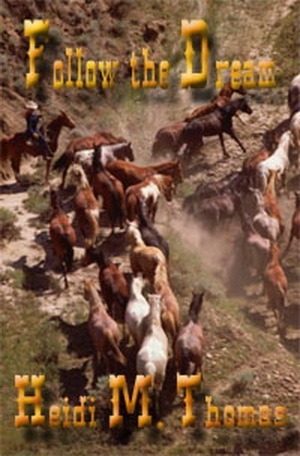 were flexing their liberation in a variety of ways.
were flexing their liberation in a variety of ways.
Some, such as Montana's Jeannette Rankin, had gone into the halls of Congress. Amelia Earhart proved she could fly airplanes with the best of the boys.
Multitudes merely bobbed their hair and became flappers in the speakeasies and blind pigs which sprang up in dark places after the women's vote helped usher in a quaint Shiite law known as Prohibition.
In the West, women rodeoed.
Not confined to sissified events such as barrel racing or goat-tying, Montana women such as Alice and Margie Greenough, Fanny Sperry Steele and Marie Gibson were busting broncs head-to-head with their male counterparts. They and trick rider Trixie McCormick were showing their stuff in Madison Square Garden and before the crowned heads of Europe in Wild West shows.
Heidi M. Thomas' grandmother, Olive May "Tootsie" Bailey grew up in the Sweetgrass-Cut Bank area near Montana's border with Alberta, loved her damned old rodeo and competed alongside the aforementioned legends.
She and her husband, Otto Gasser, ranched along the Hi-Line and then in Garfield County.
As Thomas says she visualized it:
"A petite young woman mounts a 750-pound steer, and hangs on to nothing but a rope tight-wrapped around one hand. That she stays on this bucking, twisting, snorting beast for ten seconds, eight seconds or even two seconds, seems like a miracle.
"This is the intriguing picture of my grandmother I have carried in the back of my mind since I was a little girl. Ever since I began to explore fiction writing as opposed to journalism, this idea has been nagging at me, telling me I needed to write about her."
As a girl, Thomas heard of her grandma's sagas. "She died when I was only 12, so I never got to talk to her about her life as a rodeo cowgirl," Thomas writes on her extensive website.
"But she had taken many pictures, created photo albums, scrapbook and journals, from which a story emerged. My Dad told me stories about his growing up in the 1920s and '30s. The spark grew to a flame, and I was hooked."
Living in Washington state in 1999, Thomas began setting down "Cowgirl Dreams," basing the lead character, Nettie Bradley, on her grandmother.
Ten years later, she was back in Montana on book tours for the book. She's back again this year with the story of Nettie's early married life in "Follow the Dream" and has another title on the next generation, "American Dreams" currently in revision.
According to her website, yet another novel, "Rescuing Samantha" is in progress.
 In the sequel to "Cowgirl Dreams," Nettie has been married (against parental resistance) to her cowboy, Jake Moser, and they share their dreams of rodeoing together and even raising a family on the circuit, as real-life Marie and Tom Gibson did in the 1920s and 1930s.
In the sequel to "Cowgirl Dreams," Nettie has been married (against parental resistance) to her cowboy, Jake Moser, and they share their dreams of rodeoing together and even raising a family on the circuit, as real-life Marie and Tom Gibson did in the 1920s and 1930s.
But into each dream, a little reality must fall and a lot of reality fell upon the Montana landscape in those years. The state's fledgling homestead agriculture began its death spiral in the 1920s because of a post-World War drop in prices and persistent drought on the highly leveraged land.
Banks failed and insect plagues of biblical proportions seemingly descended whenever there was sufficient rain to grow a crop worth destroying.
A reverse immigration occurred, as families pooled resources to send one of two members to the coast to earn enough money to buy train fare for remaining family members to escape ravaged Montana. Livestock –- and people – often were left to fend for themselves.
Thus, Nettie and Jake move from ranch to ranch and in 1931, decide to trail their herd of 50 horses two mountain ranges and 350 miles from Sunburst to Salmon, Idaho, where there's grass.
The struggle to keep body, soul, marriage and horse herd together marks the saga that is "Follow the Dream."
Thomas' books are classified in the "young adult" category and Treble Heart Books is a Christian publishing house, which in this case means there's no cussing or violence. Thoroughly vetted, it should interest readers of all ages.








December 24, 2010
Christmas Fun
I want to take this opportunity to wish all my followers a very Merry Christmas, Happy Holidays and a happy and healthy New Year. I celebrate the birth of Christ and I am thankful for the many blessings I've received in my life.
Here are some photos from Christmases, present and past.
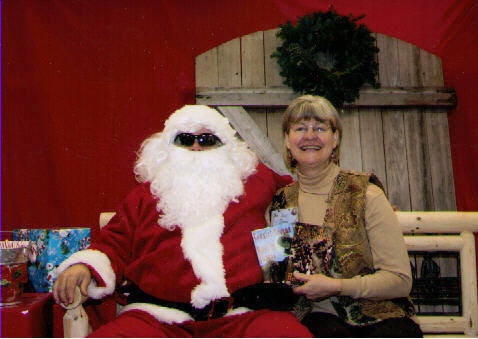 This year I did a book signing at the Country Store Farmer's Co-op and had to have my picture taken with a "cool" Santa.
This year I did a book signing at the Country Store Farmer's Co-op and had to have my picture taken with a "cool" Santa.
 Every year a group of friends gets together to bake cookies, eat, and exchange our wares. This is a special tradition and special friends. It reminds me of our family tradition on the ranch of making sugar cookies and everyone sitting at the kitchen table to decorate them.
Every year a group of friends gets together to bake cookies, eat, and exchange our wares. This is a special tradition and special friends. It reminds me of our family tradition on the ranch of making sugar cookies and everyone sitting at the kitchen table to decorate them.
 We don't always have snow in the winter here in the Pacific Northwest, but when we do, I am reminded of Christmases in eastern Montana, being snowed in, playing board games, drinking cocoa and eating Christmas goodies. This photo was from winter 2006, when we did have snow for Christmas.
We don't always have snow in the winter here in the Pacific Northwest, but when we do, I am reminded of Christmases in eastern Montana, being snowed in, playing board games, drinking cocoa and eating Christmas goodies. This photo was from winter 2006, when we did have snow for Christmas.
 Our families are scattered hither and yon, so we don't often have company for the holidays. This was from 2005, when Dave's sister, Marylou, spent Christmas with us. A special holiday!
Our families are scattered hither and yon, so we don't often have company for the holidays. This was from 2005, when Dave's sister, Marylou, spent Christmas with us. A special holiday!
Jellicle Cat (Jelli) likes to nap on the tree skirt under the tree. Probably waiting to drink the milk left out for Santa!
 One of my all-time favorite gifts!
One of my all-time favorite gifts!
However you celebrate the holiday, my best wishes to you!








December 8, 2010
Where Gable Slept
 My guest today is Irene Bennett Brown, best known for her historical novels such as The Bargain, The Plainswoman, and Haven. Irene's latest novel is a departure for her, a cozy mystery, Where Gable Slept.
My guest today is Irene Bennett Brown, best known for her historical novels such as The Bargain, The Plainswoman, and Haven. Irene's latest novel is a departure for her, a cozy mystery, Where Gable Slept.
This is an entertaining, fast-paced mystery with a blossoming romance. Celia Landrey leads tours through a historic mansion, where Clark Gable reportedly stayed, to attract tourism to her struggling community. The owner's death and the shadow of murder threatens to spoil its appeal. Then a mystery woman appears and buys the property out from under the town's preservation group, with plans to burn it down. Celia is a well-characterized and sympathetic middle-aged sleuth, and I enjoyed the story very much.
Irene, after specializing in historical fiction, what made you decide to write a mystery?
As I got older, eyesight problems made intense research difficult for my historical work. I decided to try something light, fun, set in the present day, and for the most part—my own backyard, thus requiring less research. I'd turned to reading cozy mysteries, and after studying several I became excited at the prospect of writing one.
Did you find it more difficult to write? Not really, although in the long ago past I was convinced that writing a mystery would be impossible for me–I was sure I didn't have the intellect/analytical mind a mystery puzzle would require. Maybe years of writing gave me the necessary confidence to at least try. In any event, after I had created a small-town cast of characters I loved and could work with, each with their own personality, motives, and agendas, I had a great time working out "whodunit" and "how come" in Where Gable Slept!
Which genre do you prefer? Gosh, hard answer. I love both so maybe no preference? At this time, though, I am more involved in the mystery genre.
Are you planning another cozy mystery? Yep. Where Gable Slept begins a planned series. Celia Landrey, walking-tour guide, who one reviewer referred to as "charming and indomitable" will remain as my main character. Plots will also involve other characters the reader met in book one. I'm working now on the second book, with the working title Where Danger Danced.
Why did you decide to self-publish this book? Chiefly, I did it myself because I wanted to see the book in print when and how I wanted it to appear. At this stage in my career I have less patience waiting for a traditional publisher to make a decision, which in some cases can be years. Fortunately, I have great help in that my computer-expert husband takes care of the mechanics, formatting and such, to get the book ready for the printer. My daughter is a professional artist and she designed and illustrated the cover of Where Gable Slept. I had the book professionally edited as well.
How did you get started with your writing career? I've known  since I was twelve years old that I wanted to be a writer. I began very small, writing brief anecdotes and articles for newspapers, then short stories and longer serials for children's Sunday School papers. That led to writing children's book-length fiction. I wrote nine books for children and young adults. Many were book club selections and/or were printed in both hardcover and paperback.
since I was twelve years old that I wanted to be a writer. I began very small, writing brief anecdotes and articles for newspapers, then short stories and longer serials for children's Sunday School papers. That led to writing children's book-length fiction. I wrote nine books for children and young adults. Many were book club selections and/or were printed in both hardcover and paperback.
What were some of your early influences? Easy answer; books like Little Women and Caddie Woodlawn in the children's field, and adult novels by Frank Slaughter, Janet Holt Giles, Edna Ferber, Robert Penn Warren, Jessamyn West. Countless others, I've always been a reader.
What was your first published book? To Rainbow Valley is a children's book and my first. It is a dust-bowl era story about a family who makes a new life in Oregon, much as my own family did. The book was published by David McKay in 1969 and these 40-odd years later, is still available as an easy-reader from an educational publisher, Perfection Learning.
How many books have you had published? I have had 15 children's and adult novels published by a wide range of traditional publishers—Atheneum, Ballantine, Five Star/Cengage to name a few. My two latest, The Bargain, and Where Gable Slept–making it 17–were published by my own imprint, Riveredge Books.
Do you have some tips to share with pre-published authors?
Read tons in the field in which you want to write. Revise and rewrite until your manuscript is your very best effort. Submit your work and don't let rejections get you down if this is what you truly want to do. Attend writer's conferences, learn from the speakers and network with other writers. As author Robert Fontaine said, "To be a writer is to reach, however awkwardly, for the stars, and move however haltingly, in that direction." In other words, writing is work, no doubt about it. But if a writer is what you're meant to be, nothing will give you more satisfaction and enjoyment.
Irene's books are available through her website www.irenebennettbrown.com and through local bookstores and from most on-line bookstores. Many are also available as audiobooks through www.booksinmotion.com and on-line bookstores such as www.amazon.com and www.barnesandnoble.com








December 1, 2010
Meet Joni Harms, "Cowgirl Dreams" Singer
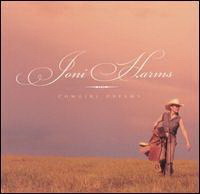 My guest today is country western singer Joni Harms. I first "met" Joni when my first novel, Cowgirl Dreams, was published. I searched the title and found that Joni had recorded an album, "Cowgirl Dreams," which has since become one of my favorites to listen to while I'm writing.
My guest today is country western singer Joni Harms. I first "met" Joni when my first novel, Cowgirl Dreams, was published. I searched the title and found that Joni had recorded an album, "Cowgirl Dreams," which has since become one of my favorites to listen to while I'm writing.
As Joni says on her website, Country Music was once known as "Country & Western." It was so called for a reason, of course, since that's where listeners found songs by such greats as Marty Robbins, Patsy Montana, Tex Ritter and Gene Autry — artists who favored the "western" sounds and values. Somewhere along the way, the "Western" was dropped and, over the past decade, the Country Music Industry has increasingly focused on the more 70s and 80s pop flavored sounds in an effort to attract a younger audience.
"The majority of the songs include lyrics of the west, because I
 love to write about things I've experienced," Joni says. "Rodeo, cowboys and the ranch way of living shows through a lot in my music."
love to write about things I've experienced," Joni says. "Rodeo, cowboys and the ranch way of living shows through a lot in my music."
Harms has been praised for her pure country voice  since she signed her first record deal with the famed producer Jimmy Bowen for Capitol in the early 1990s. After that Harms moved to on to her celebrated "Cowgirl Dreams" (1999 / Warner Western).
since she signed her first record deal with the famed producer Jimmy Bowen for Capitol in the early 1990s. After that Harms moved to on to her celebrated "Cowgirl Dreams" (1999 / Warner Western).
I recently visited with Joni as she traveled the concert circuit.
Joni, when did you know you wanted to be a country singer?
I knew I wanted to be a cowgirl singer ever since I was a little girl. I used to go out and ride my horse and write and sing my songs to her when I was only 5 or 6 years old. Always was a good listener! : – )
Who are some of the western musicians who have influenced you?
Emmy Lou Harris, Dolly Parton, Merle Haggard and Buck Owens.
What was the first song you recorded? And your first album?
"You're My Blanket" from my first CD titled "Thoughts Of You."
How has your music evolved since you started?
I think/hope my song writing skills have improved and that my story content is more interesting from all of my travels.
You've done several albums over the years. One of them is "Let's Put The Western Back In The Country" (Wildcatter Records). Tell us about the philosophy behind this title.
I have recorded 10 CDs and I am working on finishing #11 right now. "Let's Put The Western Back In The Country" was CD #9 but the title still totally sums up what I am trying to do — keep western music available to those of us who still love it and want to hear it! I personally can't live without Western music. I like a lot of today's country music, but the truth of the matter is that I'm very serious about keeping the western side of country music alive.
View Joni's Performance Video:
Let's Put Western Back In The Country from Joni Harms on Vimeo.
In 2003, Harms was named Female Vocalist of the Year and accepted the award for Song of the Year from the Western Music Association. She is also a multiple winner of Academy of Western Artists Awards, including the top honor of Entertainer of the Year for 2002, and she continues building audiences through appearances on the famed Grand Ole Opry and a recent stint at New York City's Carnegie Hall. Harms lives in Oregon with her family on a ranch that was homesteaded by her great, great grandfather in 1870. They raise quarter horses and Christmas trees.
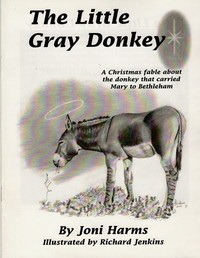 Joni has also written children's books, The Little Grey Donkey and Stan and Burt, based on a song from the CD "Are We There Yet?"
Joni has also written children's books, The Little Grey Donkey and Stan and Burt, based on a song from the CD "Are We There Yet?"
Check out Joni's website and her CDs at http://joniharms.com
Her upcoming events include a Christmas show in Slayton, Oregon, a Cowboy Gathering in Monterey, CA, and the Denver Market Show in January.








November 20, 2010
It's Blog Jog Day!
"Thank you for stopping by my Blog! Please explore all this Blog has to offer, then jog on over to "Smoke-E-Cigs" (especially if you are considering trying to kick the habit!)
If you would like to visit a different Blog in the jog, go to Blog Jog Schedule.
November 21, 2010 is the 38th annual World Hello Day. Anyone can participate in World Hello Day simply by greeting ten people. Blog jogging is a great way to do just that! Have fun exploring!








November 12, 2010
The Lost Art of the Greeting
 My guest today is Magdalena Ball who runs The Compulsive Reader. Her short stories, editorials, poetry, reviews and articles have appeared in a wide number of printed anthologies and journals. She is also the author of the poetry book Repulsion Thrust, the novel Sleep Before Evening, a nonfiction book The Art of Assessment: How to Review Anything and three other poetry chapbooks Quark Soup, and, in collaboration with Carolyn Howard-Johnson, Cherished Pulse and She Wore Emerald Then.
My guest today is Magdalena Ball who runs The Compulsive Reader. Her short stories, editorials, poetry, reviews and articles have appeared in a wide number of printed anthologies and journals. She is also the author of the poetry book Repulsion Thrust, the novel Sleep Before Evening, a nonfiction book The Art of Assessment: How to Review Anything and three other poetry chapbooks Quark Soup, and, in collaboration with Carolyn Howard-Johnson, Cherished Pulse and She Wore Emerald Then.
The Lost Art of the Greeting
by Magdalena Ball
Sending a quick greeting is an easy thing these days. Just pop a line or two onto an email message (eg HAPPY BIRTHDAY JOSH), and off it goes. Do we even need to bother with that? After all, we're all connected on social networks these days. On my birthday this year about 30 people I didn't know (and a similar number that I did) wished me a very happy birthday. I could wish my whole family Happy Chanukah with a single status update on Facebook. Or maybe I could pop down to the shop and pick up a card to say it for me: "On Valentine's Day/just wanted to say/you make my life special/in every way."
But what does "special" mean? Do I really mean "every way" (maybe not every single way…). The problem with greetings is that they really can't be done without effort. If you dash off something slapdash and fast, the meaning behind the action gets lost. In other words, passing on easy cliché may be less meaningful than no words at all. The whole point of taking the time to say something important to someone is to make a connection. It's easy to miss those connections in this fast paced, multi-tasking world of ours. Let's see – I'll cook dinner, finish a business report, bathe the kids, and send off a greeting card to my mother in the next hour. If you don't personalise or try to say something that really captures how you feel in a way that is powerful and moving, the whole point of taking the time to make that communication is lost.
When someone gives me a gift or card, what I really want is for them to have spent a few minutes thinking about me. That's the gift – the little bit of thought. A gift or card that says – you actually are in my thoughts. It's very difficult to do that with cliché. Much better to use poetry, where each word is carefully constructed – thought out, pulled together to create meaning that is entirely novel. That was the thinking behind the 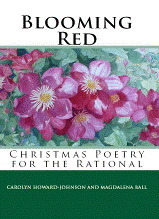 Celebration series of poetry that Carolyn Howard-Johnson and I began pulling together some years ago. We wanted to create little, beautiful gift books of poetry that wasn't cliché ridden or syrupy, but instead looked closely at particular themes like "love", holidays, fatherhood and motherhood, and captured something distinctive and new about that theme. Although the books feature lovely, full colour artwork, most are only $6.95 – about the price of a high end greeting card. This is definitely a cliché free zone! The book features a beautiful Poinsettia painting on the cover by prize-winning artist Vicki Thomas, and the books can be bought in packs of 25 for only $3 each (Put HOLIDAY ORDER in the subject line and send an e-mail to hojonews@aol.com to organise a set). The individual book can be found at: http://www.budurl.com/BloomingRed
Celebration series of poetry that Carolyn Howard-Johnson and I began pulling together some years ago. We wanted to create little, beautiful gift books of poetry that wasn't cliché ridden or syrupy, but instead looked closely at particular themes like "love", holidays, fatherhood and motherhood, and captured something distinctive and new about that theme. Although the books feature lovely, full colour artwork, most are only $6.95 – about the price of a high end greeting card. This is definitely a cliché free zone! The book features a beautiful Poinsettia painting on the cover by prize-winning artist Vicki Thomas, and the books can be bought in packs of 25 for only $3 each (Put HOLIDAY ORDER in the subject line and send an e-mail to hojonews@aol.com to organise a set). The individual book can be found at: http://www.budurl.com/BloomingRed
Here's a sample poem, which can also be listened to (in the author's own voice) at The Compulsive Reader.
Silent Symphony
Though it's calm in the dark room
where you sit on Christmas eve
reaching for familiarity
I'll take you down
to that imperfect place
of tone and sound
beyond culture's skin, language
hard wired clickity clack
auditory parasite
multiples of frequencies
simple-ratio harmonies or complex
carols of memory
down there
in the consonance of memory
walking the cobblestones of imagination
your black heart finds light
melodic intervals
of sensation more pervasive than chance
open your ears into the silence
a symphony
vibrating the universe of your illusory body.
More on Magdalena Ball can be found at her website.
To learn more about another author, check out Kathy Stemke's blog tomorrow. She's featuring Stephen Tremp who has just had his first action suspense novel released: Breakthrough.








November 9, 2010
Beloved Horses in Second Careers
 My guest today is Sharon Miner, author of three novels and four non-fiction books in the Beloved Horse series. Her newest book is
Beloved Horses in Second Careers
.
My guest today is Sharon Miner, author of three novels and four non-fiction books in the Beloved Horse series. Her newest book is
Beloved Horses in Second Careers
.
Sharon grew up in Connecticut, the middle child of eleven. An avid horse lover at an early age, she would beg her daddy to find horses during the family's drives in the countryside on Sundays. She collected glass horses and kept a scrapbook of horse pictures. As a teenager, she learned to ride and care for horses at a local riding stable. Currently, Sharon and her husband, Bob, live in Tampa, Florida and travel throughout the United States with their Irish Terrier, Woogie, interviewing riders at horse shows as well as marketing her books.
I see you've been a life-long horse enthusiast. Tell us how you got starting writing about horses. When a very special horse of mine named Fawn died, I wanted to share her story. I knew I needed to learn the steps on how to write and have a book published, so I took a writing course through the Institute of Children's Literature. After my first book was published in 1993, I worked for 12 years at a local newspaper to hone my writing skills.
Did you always want to write or was it something you decided to do later in life? My first love was horses, and I made a goal when I was 11 yrs old to have my own stable in 10 years. I accomplished that goal, and my next goal (as an adult) was to be an author.
Your newest book is Beloved Horses in Second Careers, the fourth in a series. How did you come to write this series? When I closed my Unicorn Stables after 25 years to pursue traveling, I wanted to share the magic of horses with others. As I traveled promoting the book, people I met wanted to share their horse stories – so the series was born.
You've also written three young adult novels. Do you have plans for more fiction? Yes, I'm working on a novel based on my grandfather's childhood – a hot-tempered orphan boy who was sent on an "Orphan Train" to Colorado in the late 1800's. This was the beginning of foster care. But no one was there to meet the boy, so the town drunk took 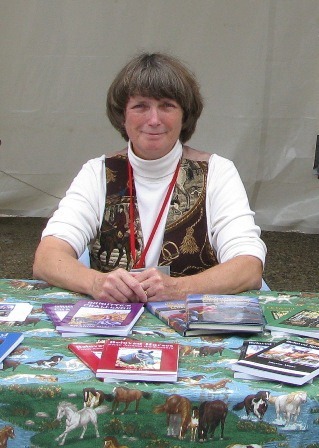 him in.
him in.
Oh, that sounds like a wonderful, exciting story!
Which do you like writing the best—fiction or non-fiction? Both!
You are also a speaker on various writing topics, including unique marketing tips. Can you share a couple of those with us? Marketing books at non-profit fundraisers/membership drives receive a great response since publicity is more likely to be printed. It's a win-win for all!
Do you still own horses and ride? My last horse from Unicorn Stables, named Sonny, is 30 yrs old and retired in NJ. I only ride maybe once a year, at a local stable in Tampa area.
What piece of advice can you offer to aspiring writers?
My advice for those wanting to write: Declare your goals (I still have that piece of paper with my 11 yr old goal), seek advice, learn the craft of writing at workshops, conferences and school/college classes, and most of all – never give up!
Sharon, thank you for sharing your riding and writing journey with us!
Sharon's books are available through her website and at Amazon.com.









